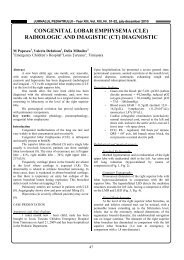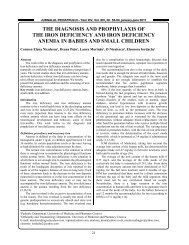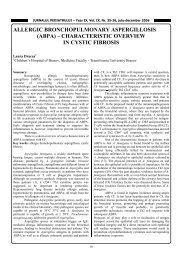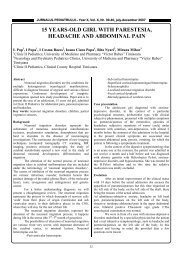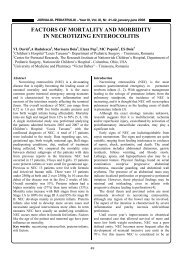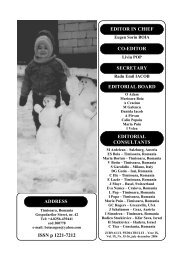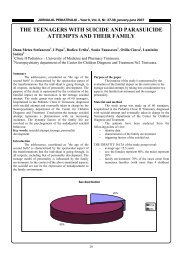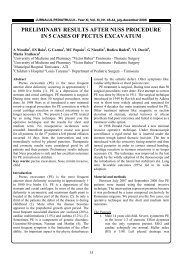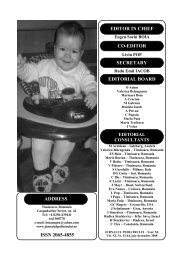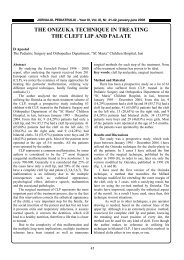address editor in chief co-editors secretary editorial board
address editor in chief co-editors secretary editorial board
address editor in chief co-editors secretary editorial board
Create successful ePaper yourself
Turn your PDF publications into a flip-book with our unique Google optimized e-Paper software.
JURNALUL PEDIATRULUI – Year XV, X<br />
, Vol. XV, Nr. 59-60<br />
60, , july<br />
j<br />
uly-december 2012<br />
Patients with ACL tears and a medial or lateral<br />
meniscus tear are more likely to have a chondral <strong>in</strong>jury <strong>in</strong><br />
that particular <strong>co</strong>mpartment than those without meniscal<br />
ruptures.<br />
Regard<strong>in</strong>g the most appropriate graft choice there is<br />
grow<strong>in</strong>g support <strong>in</strong> favor of autologus hamstr<strong>in</strong>gs<br />
(semitend<strong>in</strong>osus and gracilis) and <strong>co</strong>ncern with bone –<br />
patellar tendon – bone s<strong>in</strong>ce the bone plugs have led to<br />
premature physeal ossifications <strong>in</strong> animal models. Gebhard<br />
et al [4] analyzed twenty-eight patients who underwent ACL<br />
re<strong>co</strong>nstruction with hamstr<strong>in</strong>gs, 16 patients with bonepatella-bone,<br />
12 patients with quadriceps grafts and 12<br />
patients with facia lata. The mean follow-up was 32 months.<br />
Neither leg length discrepancy nor angular deformities were<br />
noted. None of the four methods studied showed major<br />
differences <strong>in</strong> out<strong>co</strong>me <strong>co</strong>mpared to the other.<br />
Thus, surgical stabilization should be <strong>co</strong>nsidered as the<br />
first l<strong>in</strong>e of treatment for immature patients with ACL tears.<br />
The exist<strong>in</strong>g literature suggests that transphyseal<br />
re<strong>co</strong>nstruction can be safely done <strong>in</strong> this population if a few<br />
rules are <strong>co</strong>nsidered, and there are physeal-spar<strong>in</strong>g<br />
procedures that provide excellent results with less<br />
theoretical risk to the growth plate. Conservative or delayed<br />
surgical treatment, which carries an <strong>in</strong>creased risk of<br />
se<strong>co</strong>ndary jo<strong>in</strong>t <strong>in</strong>jury, should be reserved only for selected<br />
cases [5].<br />
This change of perspective has not been fully agreed<br />
upon especially regard<strong>in</strong>g surgical procedure with respect to<br />
physeal growth plates. Moksnes et al [6] performed a recent<br />
literaure review and found that there is no <strong>co</strong>nsensus on the<br />
management of anterior cruciate ligament <strong>in</strong>juries <strong>in</strong><br />
skeletally immature children, and the methodological quality<br />
of published studies is questionable. The transphyseal<br />
re<strong>co</strong>nstructions, physeal-spar<strong>in</strong>g re<strong>co</strong>nstructions, and<br />
nonoperative treatment algorithms that are advocated have<br />
little supportive data.<br />
In our center we have been perform<strong>in</strong>g over 150<br />
ACL re<strong>co</strong>nstructions every year. A recent analysis has<br />
revealed an <strong>in</strong>crease <strong>in</strong> the percentage of skeletally<br />
immature which has led us to perform a review of the<br />
literature and our cases <strong>in</strong> order to evaluate our current<br />
standard of treatment.<br />
Material and Method<br />
For this purpose we performed a retrospective<br />
evaluation of our <strong>co</strong>hort of pediatric ACL re<strong>co</strong>nstructions.<br />
Criteria for <strong>in</strong>clusion were up to 15 years of age for girls and<br />
17 for boys at <strong>in</strong>dex surgery and open physis evaluated<br />
us<strong>in</strong>g postoperative x-rays. These were the only reliable<br />
measurements available, even though <strong>in</strong> the literature the<br />
standard bone age evaluation for pediatric ACL<br />
re<strong>co</strong>nstructions is the one proposed by Tanner and<br />
Whitehouse; this system s<strong>co</strong>res 20 <strong>in</strong>dicators on hand and<br />
wrist radiograph, yield<strong>in</strong>g total s<strong>co</strong>res rang<strong>in</strong>g from 0 to<br />
100. However, we were not able to use this scale <strong>in</strong><br />
retrospect. 4 girls and 3 boys met the <strong>in</strong>clusion criteria out<br />
of 628 <strong>co</strong>nsecutive cases operated by a s<strong>in</strong>gle surgeon over<br />
the last 5 years. The girls were 13, 14 and two 15<br />
respectively and the boys were 15 and two 16. The probable<br />
estimate Tanner stage was III and IV. Example of MRI<br />
appearance can be seen <strong>in</strong> fig.1 - 3.<br />
Fig.1 RISE and fig. 2 T1 sagittal and fig. 3 T1 <strong>co</strong>ronal views of 16 years old boy with open physis and ruptured ACL.<br />
Results<br />
All had subjective <strong>in</strong>stability and received s<strong>in</strong>gle bundle<br />
transphyseal primary ACL re<strong>co</strong>nstruction performed by the<br />
same surgeon us<strong>in</strong>g quadruple hamstr<strong>in</strong>gs (semitend<strong>in</strong>osus<br />
and gracillis) with <strong>co</strong>rtical femoral and absorbable<br />
<strong>in</strong>terference screw tibial fixation (fig.4 – 9). All patients had<br />
associated lesions: 5 chondral, 3 <strong>in</strong>ternal 2 external and one<br />
both menisci; all meniscal lesions were <strong>address</strong>ed by partial<br />
resection. Time from <strong>in</strong>jury to surgery was on average 9.1<br />
weeks (5 to 17).<br />
38



